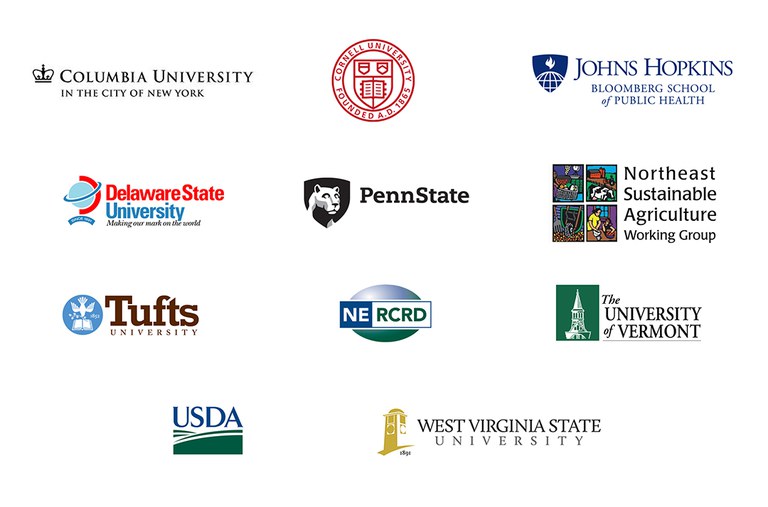Posted: February 12, 2018
For seven years a multidisciplinary team of more than 40 researchers has explored the extent to which a more robust regional food system in the Northeastern U.S. could improve food access in low-income communities and improve the long-term food security of the entire Northeast. Now, in an initial collection of three papers published in the Journal of Agriculture, Food Systems, and Community Development, team members have summarized some of their findings.

From 2011-2018, the EFSNE team engaged professionals from multiple universities, non-profits and government agencies.
One paper explores the Northeast food system in terms of the project's "market basket," an instrument frequently used in food environment and cost studies. The other papers examine lessons learned from stakeholder engagement activities conducted at nine rural and urban locations, and consumer perceptions of the concept of regional food.
These wide-ranging but inter-connected topics hint at the complex nature of the USDA-funded project, titled Enhancing Food Security in the Northeast through Regional Food Systems (EFSNE). As Christian Peters (Tufts University), a member of the EFSNE leadership team, and his co-authors wrote in their introduction to the three papers, "We have taken an interdisciplinary, systems approach to understanding food security. Recognizing that food security issues require insights from multiple disciplines and knowledge-sharing between researchers and community practitioners, we used multiple quantitative and qualitative methods in the project."
One major component of a food system is the supply chain which encompasses production, distribution, and consumption. The first paper in the collection, titled "Using a market basket to explore regional food systems" discusses the findings from the project's production, distribution, and consumption research teams. Lead author Kate Clancy, a food systems consultant and Deputy Director of the EFSNE project, and her co-authors examined the Northeast food system through the lens of an eight-product market basket that served as the research focal point for the entire project team.
"The research teams agreed on a market basket of eight foods that allowed us to examine the same foods through the lenses of multiple disciplines," Clancy said. "As a result, we're able to tell a rich story about this specific set of foods, their supply, and what opportunities exist to enhance their production and distribution in the region."
Take potatoes, for example. In examining the consumption aspects of the food system, the project's researchers found that, among a sample of consumers surveyed, those participating in food assistance programs (such as SNAP) purchased potatoes significantly more often than non-participants in the previous month. Researchers looking at distribution conducted detailed potato supply chain case studies in selected stores in the region. They quantified the economic value added by all parts of the chain. Production-focused researchers used a geo-spatial crop modeling tool to compare current potato production with potential production in the Northeast under different climate scenarios.
The second paper focuses on EFSNE's varied community engagement efforts which were led by Kathryn Ruhf (Northeast Sustainable Agriculture Working Group). In a commentary titled, "Engaging multiple audiences: Challenges and strategies in complex food systems projects," Ruhf and co-authors describe the project's stakeholder engagement framework. They recount activities the Outreach Team led to obtain input and foster dialogue between researchers and a diverse set of stakeholders groups from project community members to other researchers around the country. The authors describe the outcomes of those efforts and offer several lessons learned about achieving community engagement in the context of a large, complex research project.
The third paper, "Between global and local: Exploring regional food systems from the perspectives of four communities in the U.S. Northeast," is an analysis of four focus groups conducted by members of the project's Consumption Team, led by Anne Palmer (Center for a Livable Future, Johns Hopkins Bloomberg School of Public Health). The study reveals a number of insights into how consumers define their region, their perceived value of regionally grown food, and their tendency to conflate local and regional. For instance, immigrants and rural dwellers expressed more nuanced perspectives on the local and regional scales and were more likely to embrace the regional scale than their non-immigrant and urban counterparts. In focus group discussions, immigrants were more likely to cite imported foods as appealing and sometimes necessary--especially if they are from that person's country of origin. Based on their findings, Palmer and co-authors identify several opportunities to grow support for regional food system expansion that do not rely on widespread consumer appreciation of the benefits of regional approaches.
The three papers and their introduction are the first of more than ten manuscripts planned to summarize findings from the EFSNE project. From 2011-2018, the EFSNE team engaged professionals from multiple universities, non-profits and government agencies. Together, they addressed the question of whether greater reliance on regionally produced food could improve food access in low-income communities, while also benefiting farmers, food supply chain firms and others in the food system.

